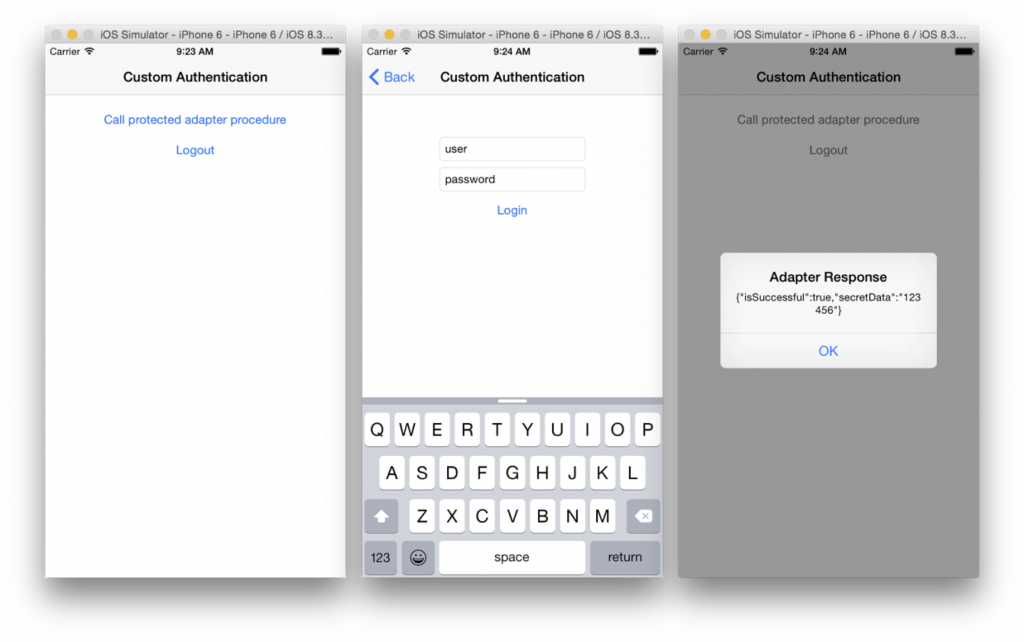Custom Authentication in native iOS applications
improve this page | report issueOverview
This tutorial explains how to implement the client side of a custom authentication in native iOS.Prerequisite: Make sure that you read the Custom Authentication tutorial first.
Implementing client-side authentication
Create a native iOS application and add the MobileFirst native APIs as explained in the Configuring a native iOS application with the MobileFirst Platform SDK tutorial.
Storyboard
In your storyboard, add a ViewController that contains a login form.

Challenge handler
- Create a
MyChallengeHandlerclass as a subclass ofChallengeHandler.
@interface MyChallengeHandler : ChallengeHandler - Call the
initWithRealmmethod:
@implementation MyChallengeHandler //... -(id)init:{ self = [self initWithRealm:@"CustomAuthenticatorRealm"]; return self; }= - Add the implementation of the following
ChallengeHandlermethods to handle the custom authenticator and login module challenge:-
isCustomResponsemethod:
TheisCustomResponsemethod is invoked each time a response is received from the MobileFirst Server. It is used to detect whether the response contains data that is related to this challenge handler. It must return eithertrueorfalse.-(BOOL) isCustomResponse:(WLResponse *)response { if(response && [response getResponseJson]){ if ([[response getResponseJson] objectForKey:@"authStatus"]) { NSString* authRequired = (NSString*) [[response getResponseJson] objectForKey:@"authStatus"]; return ([authRequired compare:@"required"] == NSOrderedSame); } } return false; } -
handleChallengemethod:
IfisCustomResponsereturnstrue, the framework calls thehandleChallengemethod. This function is used to perform required actions, such as hiding the application screen and showing the login screen.-(void) handleChallenge:(WLResponse *)response { NSLog(@"A login form should appear"); LoginViewController* loginController = [self.vc.storyboard instantiateViewControllerWithIdentifier:@"LoginViewController"]; loginController.challengeHandler = self; [self.vc.navigationController pushViewController:loginController animated:YES]; } onSuccessandonFailuremethods:
At the end of the authentication flow, calls to theonSuccessoronFailuremethods are triggered.- Call the
submitSuccessmethod to inform the framework that the authentication process completed successfully, so that theonSuccesshandler of the invocation is called. - Call the
submitFailuremethod to inform the framework that the authentication process failed, so that theonFailurehandler of the invocation is called.
-(void) onSuccess:(WLResponse *)response { NSLog(@"Challenge succeeded"); [self.vc.navigationController popViewControllerAnimated:YES]; [self submitSuccess:response]; } -(void) onFailure:(WLFailResponse *)response { NSLog(@"Challenge failed"); [self submitFailure:response]; }- Call the
-
submitLoginForm
In your login View Controller, when the user types to submit the credentials, call the submitLoginForm method to send the credentials to the MobileFirst Server.
@implementation LoginViewController
//...
- (IBAction)login:(id)sender {
[self.challengeHandler
submitLoginForm:@"/my_custom_auth_request_url"
requestParameters:@{@"username": self.username.text, @"password": self.password.text}
requestHeaders:nil
requestTimeoutInMilliSeconds:0
requestMethod:@"POST"];
}
The Main ViewController
In the sample project, in order to trigger the challenge handler we use the WLClient invokeProcedure method.
The protected procedure invocation triggers MobileFirst Server to send the challenge.
- Create a
WLClientinstance and use theconnectmethod to connect to the MobileFirst Server:
MyConnectListener *connectListener = [[MyConnectListener alloc] init]; [[WLClient sharedInstance] wlConnectWithDelegate:connectListener]; - In order to listen to incoming challenges, make sure to register the challenge handler by using the
registerChallengeHandlermethod:
[[WLClient sharedInstance] registerChallengeHandler:[[MyChallengeHandler alloc] initWithViewController:self] ];<br /> - Invoke the protected adapter procedure:
NSURL* url = [NSURL URLWithString:@"/adapters/AuthAdapter/getSecretData"]; WLResourceRequest* request = [WLResourceRequest requestWithURL:url method:WLHttpMethodGet]; [request sendWithCompletionHandler:^(WLResponse *response, NSError *error) { ... }];
Worklight Protocol
If your custom authenticator uses WorklightProtocolAuthenticator, some simplifications can be made:
- You can subclass your challenge handler by using
WLChallengeHandlerinstead ofChallengeHandler. Note theWL. - You no longer need to implement
isCustomResponsebecause the challenge handler automatically checks that the realm name matches. - The
handleChallengemethod receives the challenge as a parameter, not the entire response object. - Instead of
submitLoginForm, usesubmitChallengeAnswerto send your challenge response as a JSON object. - You do not need to call
submitSuccessorsubmitFailurebecause the framework will do it for you.
For an example that uses
WorklightProtocolAuthenticator, see the Remember Me tutorial or this video blog post.
Sample application
Click to download the MobileFirst project.
Click to download the Objective-C project.
Click to download the Swift project.
- The
CustomAuthproject contains a MobileFirst native API that you can deploy to your MobileFirst server. - The
CustomAuthObjCandCustomAuthSwiftprojects contains a native iOS application that uses a MobileFirst native API library. - Make sure to update the
worklight.plistfile in the native project with the relevant server settings.

Inclusive terminology note: The Mobile First Platform team is making changes to support the IBM® initiative to replace racially biased and other discriminatory language in our code and content with more inclusive language. While IBM values the use of inclusive language, terms that are outside of IBM's direct influence are sometimes required for the sake of maintaining user understanding. As other industry leaders join IBM in embracing the use of inclusive language, IBM will continue to update the documentation to reflect those changes.